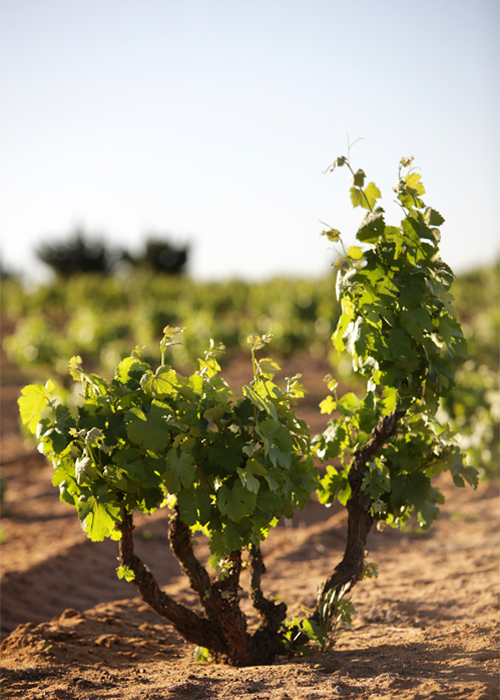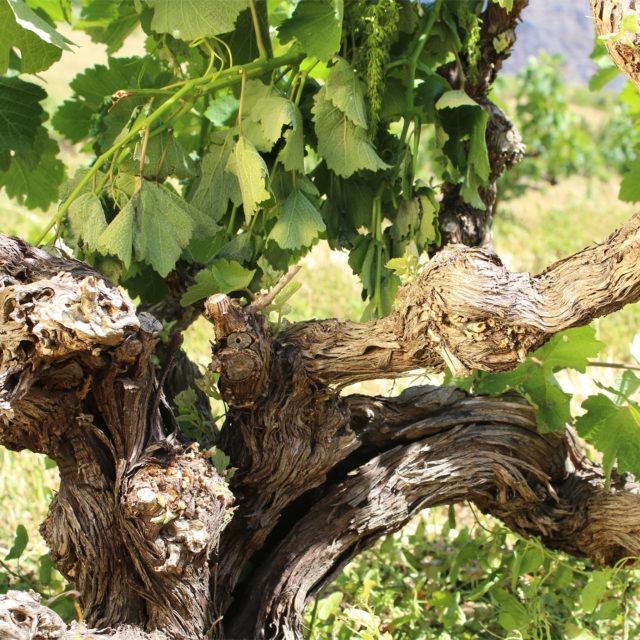One day last February, in South Africa’s Franschhoek Valley, Gary Baumgarten, managing director of Anthonij Rupert Wyne, joined a group in his tasting room who were visiting on behalf of Wines of South Africa. It was the height of South Africa’s 2019 harvest, and temperatures were 107 degrees Fahrenheit. The heat had followed three years of drought.
“Welcome to climate change, guys,” Baumgarten said.
If there’s a wine likely to survive these conditions, it’s one like this. A David & Nadia Hoë-Steen Chenin Blanc, it came from dry-farmed vineyards planted over half a century ago. Those tough, old Chenin bush vines have longevity on their side.
Don't Miss A Drop
Get the latest in beer, wine, and cocktail culture sent straight to your inbox.“Old vines do pretty well in adverse conditions, especially drought, particularly due to their well-established root systems,” Andre Morgenthal, project manager for South Africa’s Old Vine Project (OVP), and our host for the tasting, said. OVP member wineries use grapes from vines at least 35 years old, a status indicated on bottles with the OVP’s Certified Heritage Vineyards seal.
The Project is the brainchild of viticultural consultant Rosa Kruger, who’s been hunting down South Africa’s forgotten vines since 2002. The diversity of her discoveries is impressive. Though they make up just 3 to 4 percent of all South African plantings, OVP-registered vines comprise 48 varieties. Approximately half of these are Chenin Blanc.
That’s largely because there’s so much Chenin in South Africa altogether. Once known by its old Dutch name, Steen, it was brought here in the 1650s. Under the Koöperatieve Wijnbouwers Vereniging van Suid-Afrika (KWV), which dominated production in the 20th century until apartheid’s end in the 1990s, Chenin was widely planted for South Africa’s popular brandy. It’s still the nation’s most cultivated variety.
The reasons for the vines’ longevity, though, remain the subject of OVP research. Many suffer viruses, but with the help of vine nursery Vititec, the OVP has been cleaning up neglected vines and propagating disease-free materials from them for “new” heritage vineyards at Anthonij Rupert. By doing this, the OVP is creating a living archive — and one that is adapted to South African conditions.
“I believe the oldest vineyards in South Africa have mutated to plants that reflect the landscape, the sun and the wind and the rain typical to that site and typical to the South African climate,” says Morgenthal, who also believes “old-vine South African Chenin represents some of the best white wine in the world, different from, for example, Loire Chenin, solely because of the abundance of sunshine, unique ancient soils, and clonal materials, weathered over centuries.”
Bosman Family Winery’s Optenhorst Chenin Blanc, made from bush vines dating to 1952, with its banana-like notes and abundant minerality; Bellingham The Bernard Series Old Vine Chenin’s big, rich texture and bitter-herb finish evocative of South Africa’s fynbos, or scrublands; Mullineux’s Leliefontein Quartz Chenin’s opulent mouthfeel and snappy, pineapple acidity, indicative of its quartz-laden soils — these wines are not only delicious, they are uniquely South African.
Unlike the wetter, cooler, limestone Loire, where a touch of RS (residual sugar) is left in the wines to balance out their acid, South Africa’s Chenins are mainly vinified bone-dry, but they’re characterized by a natural, velvety mouthfeel that’s amplified as the vines age. “Yields come down and the bunches and berries are smaller,” says winemaker Christopher Mullineux of Mullineux and Leeu Family Wines. “You get more natural extract from these small berries, and that is where the natural textures come from.”
Indeed, sensory researchers at Stellenbosch University found that old-vine Chenins exhibit complex aromas and concentrated, balanced, lengthy mouthfeel. “Grapes on older vines ripen later, have a lower pH, higher acidity, and lower sugar,” Morgenthal says. “It’s an ideal analysis for a wine.”
That is, if the vines are treated right. Kruger learned the hard way. “During the first years I tried to cut life back into the old vines with pruning shears. I made a terrible mistake,” she says. Heavy pruning weakens old vines. “Now, with our new pruning techniques, shaping the vine from the best wood on the plant, we have increased quality and volume,” she says.
The same goes for fertilizing, which Kruger does sparingly and organically. “We have the best results when we treat these lovely old plants with dignity,” she advises vineyards. “Listen to them as if you are talking to your grandmother.”

A light touch in the vineyard allows for more of the same in the winery. Says Mullineux, “If you have healthy old vines, it tends to be easier to make low-intervention wines, as the fruit is in a better natural balance.”
In its membership agreement, the Old Vine Project encourages minimalist techniques, eschewing added acid, sulphur, new oak, and commercial yeast. Many old-vine Chenins are the result of spontaneous fermentation with extended lees contact in old wood and, sometimes, concrete or amphora. Luscious wines with exuberant, tropical flavors, they are made to express their terroir.
Of course, we can’t separate terroir from history. A 35-year-old vine planted under apartheid has racialist exploitation embedded in its wood. And today, though South African organizations like the Wine and Agriculture Ethical Trade Association promote ethics in labor relations, a 2011 Human Rights Watch report found widespread labor abuses in the South African wine industry. These included substandard and insecure housing on winery lands, harsh working conditions and overly long hours, safety hazards such as pesticide exposure, lack of access to drinking water, opposition to unionizing, and more.
Says biodynamic viticulturist Johan Reyneke, who worked in vineyards in the 1990s before launching his own Reyneke Wines: “My colleagues were poor; they were working as kids. It just sucked. One cold day in the vineyard, I put my surfing wetsuit on under my clothes, but my colleagues, they shoved newspaper in their shoes to stay warm. I said, ‘If I stay in this industry, things must change.’”
As Human Rights Watch found, however, not all wineries have poor labor practices. Reyneke launched his Cornerstone wine series to dedicate its proceeds to education, housing, and retirement annuities for his workers and their families. Similarly, at Bosman Family Wines, a Fairtrade brand, workers own 26 percent of the business and 430 hectares of Bosman land.
“We are very cognizant of our legacy, specifically the current working and living conditions of our workers,” Morgenthal says. The Project trains workers, he says, “to elevate their skills to master pruner level,” and has developed a trading platform for old-vine grapes “to benefit grape growers, brand owners, and, ultimately, vineyard workers.”
The idea is that old-vine skills, grapes, and wines can garner higher prices, so there’s more cash in the system to raise the living standards for everyone.
As Mullineux argues, “If we cannot sell our wine for a fair price, then everybody in the Swartland struggles, and we cannot break the cycles of the past.”
10 Old-Vine Chenin Blanc Wines to Try
Not every old-vine winery is a member of the Old Vine Project, but each wine below meets the OVP’s 35-year-old threshold and is available in the States:
Beaumont Hope Marguerite Chenin Blanc 2018
Left 10 months on the lees in 15 percent new wood, this wine from vines planted in 1974 and 1978 on the Cape South Coast balances beautifully between oak-driven oomph and a pineapple-citrus acidity. Price $37.99.
Botanica Mary Delany Series Chenin Blanc 2017
From dry-farmed bush vines dating to 1957, this wine shows juicy Asian pear notes and a touch of spiciness with a flinty finish. Price $26.94.
David & Nadia Hoë-Steen Chenin Blanc 2017
This apple-bright wine comes from low bush vines planted in decomposed granite, shale mix, and iron-rich clay soils between 1963 and 1982. Price $79.94.
Hogan Chenin Blanc 2016
Full malolactic fermentation gives this creamy wine from 40-year-old Swartland vines an exuberant, nearly gewürztraminer bouquet and big papaya-like flavor, balanced by a bright, bitter finish. Price $41.99.
Ken Forrester The FMC 2018
A boom-boom vanilla richness and intense, snappy apricot fruit battle it out in this Stellenbosch bottle vinified from 46-year-old bush vines and aged a year in barrel. Price $56.99.
Joostenberg Die Agteros Chenin Blanc 2018
Vinified from 38-year-old Stellenbosch vines in a mix of new oak and concrete eggs, this bargain organic wine has the weighty texture to linger over but the gingery acid to make it terrifically refreshing. Price $15.94.
Momento 2015
Abetted by 9 percent Verdelho, this Chenin Blanc blended from 35-year-old Swartland vines and ones just a tad younger in Bot River smells of ripe mango and guava with a lush, savory mid-palate that resolves to a green-apple bite. Price $32.99.
Mullineux Granite Chenin Blanc 2017
One of three single-terroir expressions by the winery, this fresh-faced Chenin from 40-year-old vines dry farmed in Paardeberg’s decomposed granite soils has a tart nose but a velvety mouthfeel and a bittersweet finish reminiscent of roasted endive. Price $69.97.
Mullineux Straw Wine 2017
From a mix of old vines at least 37 years old grown in granite and schist soils, this luscious, passito-style dessert wine balances nectary sweetness with dried-apricot brightness. Price $49.96 for 375 ml.
Reyneke Chenin Blanc Natural Wine 2016
Cold-fermented and matured in clay amphora, this unique Chenin Blanc from a biodynamic Stellenbosch producer working with vines over 40 years old has a nutty, umami character with a hint of sweet smoke, like that of roasted almonds or butter-braised enoki mushrooms. Price $68.99
This story is a part of VP Pro, our free content platform and newsletter for the drinks industry, covering wine, beer, and liquor — and beyond. Sign up for VP Pro now!
